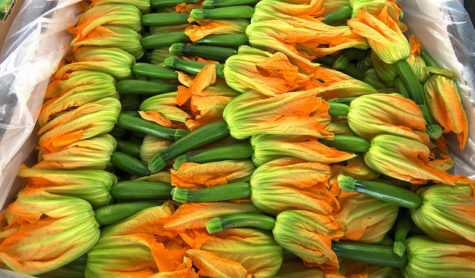
This post originally ran last summer. This summer, we tried to do better–we only planted two squash plants. Still, we went to dinner at a friend’s house last night and left behind a very large zucchini.
At dinner for my 18th birthday, one of my friends gave me one of those long, narrow posters filled with advice and inspiration that were popular at the time. I don’t have the poster in front of me, but there were things like this: Never wash a car, mow a lawn, or buy a Christmas tree after dark. When you lose, don’t lose the lesson. Approach love and cooking with reckless abandon.
And then there was this gem: Plant zucchini only if you have lots of friends.
For some reason, we found this hilarious. We laughed and laughed. (I can’t quite remember, but I think water came out my nose.) That year, seniors were allowed to “will” their classmates things in the school newspaper: at least one person willed me zucchini.
Years have passed, and in between, I forgot this important lesson. Now we have one zucchini plant. And I am running out of friends. (We also have a lot of kale, but that’s another story.)
Zucchini grown from seed usually takes five to seven weeks to start fruiting. And when it fruits, it really fruits—there’s a new one out there almost every day. Over the season, most plants produce anywhere from three to nine pounds of the young zucchini, which is what we like to eat. If you leave them too long, they get big, but also seedy and not so tasty.
The zucchini fruit is another one of those things that we usually call a vegetable. Zucchinis are the ovaries of the plant; they grow behind the female zucchini flower after bees bring it pollen from the male flower. The whole fruit/vegetable thing confuses me, but I’m not alone—only 14 percent of the 480 people surveyed by a British gardening website thought zucchini (also known as courgettes) were a fruit. Other tricky fruits included peapods, butternut squash, eggplants, and pumpkins.
Whatever you call it, the zucchini has a long history. Its ancestors were cultivated in the Americas for thousands of years; one account cites archeological findings of its relatives in 7,000 B.C.E. in Mexico. European explorers brought the prolific summer squash plant back home with them. Italians called it zucchino, the French courgette.
The zucchini we’re growing is a variegated dark and light green. We’re also growing yellow summer squash, which is equally bountiful. But it turns out even though they look very different, they’re all part of the same species (as are winter squash and pumpkins) which has morphed into different forms over time and with enthusiastic breeding.
That’s what zucchini seem like to me: a measure of enthusiasm. At the beginning of summer, they burst out in orange flowers, then proceed to produce at a breakneck pace. I imagine the zucchini plant at the end of the summer, lying back on the couch, an ice pack on its head, its eyes closed. Good work, I want to say to the zucchini. You made it.
But in the meantime, here I am, with the fruits of its labor. It turns out the number of friends you have on Facebook isn’t important, as I should have learned so long ago. What really matters is the number of people who will take your zucchini.
**
Image by Flickr user Bennilover/Creative Commons license
Great piece!
Back in the 70s, I was amused that the zucchini cookbook sold at the local bookstore in Santa Cruz was published by Planned Parenthood. Most of us Saturday gardeners did not anticipate the large zucchini family we would have around July.